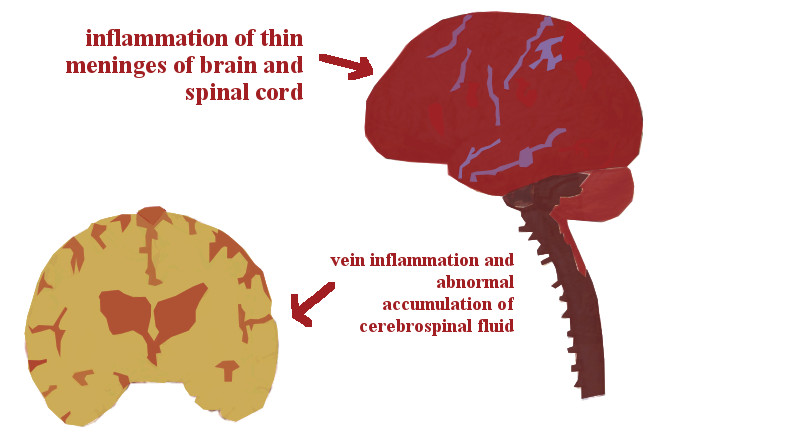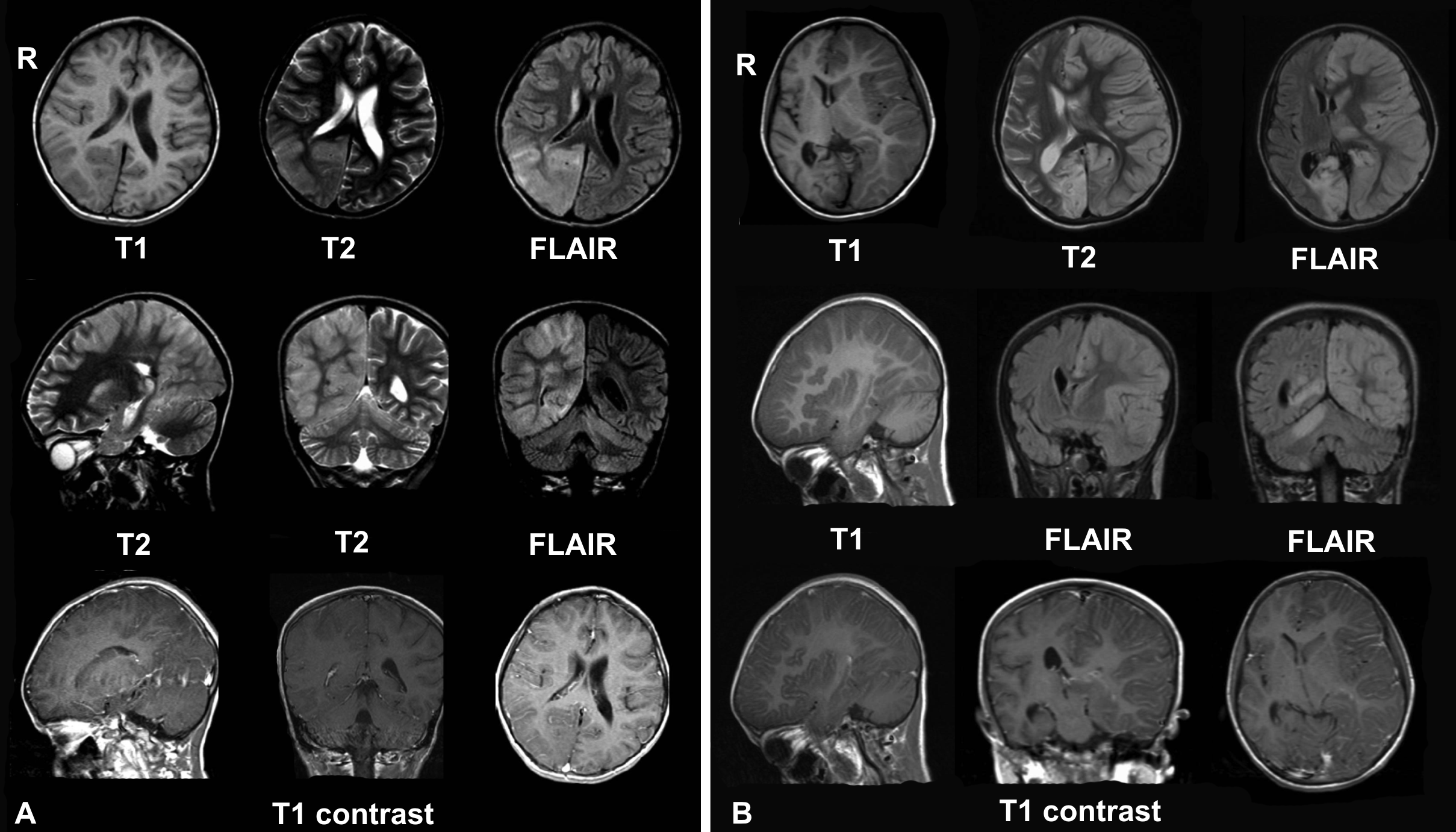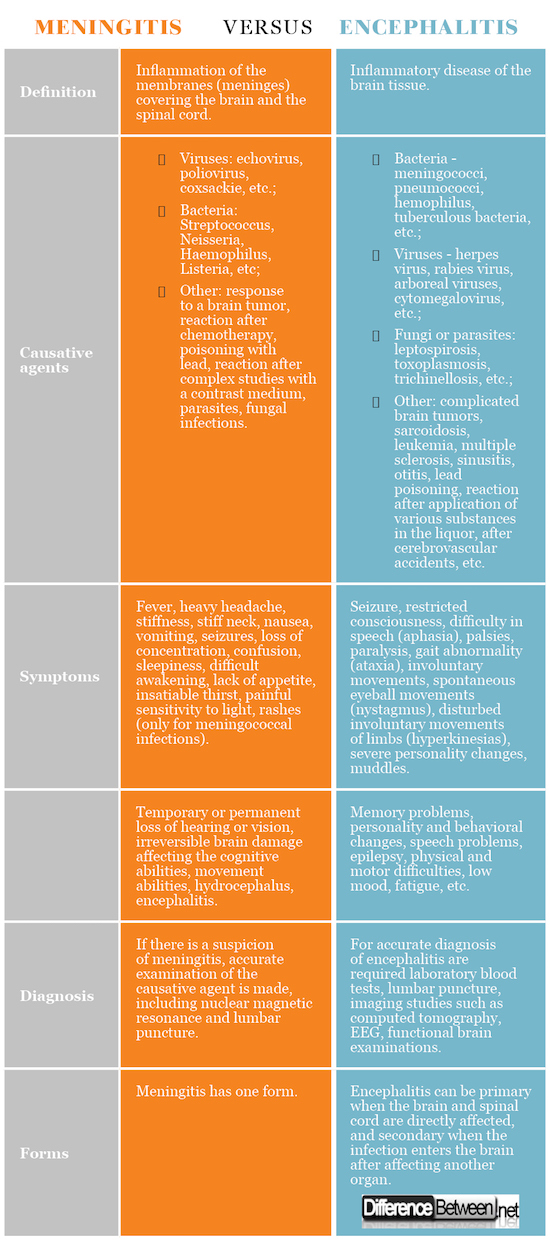Difference Between Meningitis and Encephalitis
What is Meningitis?
Meningitis is inflammation of the membranes (meninges) covering the brain and the spinal cord.
There are two main types:
- Viral meningitis – viruses are the causative agent in 80% of the cases;
- Bacterial meningitis- Caused by bacteria
Viral meningitis is caused by more than 50 types of viruses. The most common are echovirus, poliovirus, and coxsackie. Bacterial meningitis develops under the action of Streptococcus, Neisseria, Haemophilus, Listeria, and other bacteria.
Not all cases of meningitis are directly caused by viruses or bacteria.
Causes:
Meningitis may be caused by:
- Response to a brain tumor;
- Reaction after a chemotherapy;
- Poisoning with lead;
- Reaction after complex studies with a contrast medium;
- Parasites, fungal infections.
Often the onset of meningitis resembles a flu-like condition. The symptoms of meningitis develop within a few hours to a couple of days.
Symptoms:
The symptoms of meningitis are:
- Fever – rises suddenly;
- Heavy headache;
- Stiffness, stiff neck;
- Nausea and / or vomiting;
- Seizures;
- Loss of concentration, confusion;
- Sleepiness, difficult awakening;
- Lack of appetite, insatiable thirst;
- Painful sensitivity to light;
- Rashes – only for meningococcal infections.
If there is a suspicion of meningitis accurate examination of the causative agent is made, including nuclear magnetic resonance and lumbar puncture.
Bacterial meningitis can lead to severe complications and it is therefore important that antibiotic treatment begins as soon as possible. Antibiotics are given together with vitamins, anti-inflammatory and, if necessary, analgesic products. Virus meningitis is not as severe as the bacterial one. However, it should not be underestimated and should be subject to a supportive therapy.
Complications may occur in severe, late-diagnosed or neglected meningitis. The most common complications are:
- Temporary or permanent loss of hearing or vision;
- Irreversible brain damage, affecting the cognitive abilities, movement abilities, etc.;
- Hydrocephalus;
- Encephalitis.
Vaccines of varying effectiveness exist against the following bacterial causes of meningitis:
- Streptococcus pneumoniae;
- Neisseria meningitides;
- Mycobacterium tuberculosis.
Reasons for the significant percent mortality are the late or erroneous diagnosis of bacterial meningitis, inappropriate treatment, accompanying diseases and weak immune system, as well as the increasing resistance of bacteria to antibiotics.
What is Encephalitis?
Encephalitis is an inflammatory disease of the brain tissue. The most common causative agents of encephalitis are:
- Bacteria – often occurring as meningoencephalitis caused by meningococci, pneumococci, hemophilus, tuberculous bacteria, etc.);
- Viruses (herpes virus, rabies virus, arboreal viruses, cytomegalovirus, etc.);
- Fungi or parasites such as leptospirosis, toxoplasmosis, trichinellosis, etc.
Encephalitis may also occur with non-infectious etiology in patients with:
- Complicated brain tumors;
- Sarcoidosis;
- Leukemia;
- Multiple sclerosis;
- Lead poisoning;
- Reaction after application of various substances in the liquor;
- Cerebrovascular accidents, etc.
In some of the viral encephalitis, symptoms can be very discreet and include fever, general malaise, and fatigue. Most often, however, encephalitis has a clinical picture that reveals disturbed brain function. Symptoms include:
- Seizures;
- Restricted consciousness;
- Difficulty in speech (aphasia);
- Gait abnormality (ataxia);
- Palsies and paralysis;
- Involuntary movements;
- Spontaneous eyeball movements;
- Disturbed involuntary movements of limbs;
- Severe personality changes;
- Muddles.
The complications, which may occur are memory problems, personality and behavioral changes, speech problems, epilepsy, physical and motor difficulties, low mood, fatigue, etc.
Bacterial encephalitis is treated with antibiotics according to the isolated causative agent and its sensitivity to antibiotics. Vaccines exist against some types of encephalitis:
- Tick-borne encephalitis vaccine;
- Japanese encephalitis vaccine.
For accurate diagnosis of encephalitis are required laboratory blood tests, lumbar puncture, imaging studies, such as computed tomography, EEG functional brain examinations.
The specific treatment is determined by the etiology of encephalitis in the specific case.
Encephalitis can be:
- Primary: the brain and spinal cord are directly affected.
- Secondary: the infection enters the brain after affecting another organ.
The types of encephalitis are:
1. Polyoencephalitis – localized in the gray matter of the brain/spinal cord;
2. Leucoencephalitis – localized in the cerebral white brain matter;
3. Panencephalomyelitis – localized in the gray and white matter of the brain/spinal cord;
4. Perivenous encephalomyelitis.
Difference Between Meningitis and Encephalitis
-
Definition
Meningitis: Meningitis is an inflammation of the membranes (meninges) covering the brain and spinal cord.
Encephalitis: Encephalitis is an inflammatory disease of the brain tissue.
-
Causative agents
Meningitis: Viruses: echovirus, poliovirus, coxsackie, etc.; Bacteria: Streptococcus, Neisseria, Haemophilus, Listeria, etc; Other: response to a brain tumor, reaction after a chemotherapy, poisoning with lead, reaction after complex studies with a contrast medium, parasites, fungal infections.
Encephalitis: Bacteria – most often occurring as meningoencephalitis caused by meningococci, pneumococci, hemophilus, tuberculous bacteria, etc.; Viruses – herpes virus, rabies virus, arboreal viruses, cytomegalovirus etc.; Fungi or parasites: leptospirosis, toxoplasmosis, trichinellosis, etc.; Other: complicated brain tumors, sarcoidosis, leukemia, multiple sclerosis, lead poisoning, reaction after application of various substances in the liquor, after cerebrovascular accidents, etc.
-
Symptoms
Meningitis: The symptoms of meningitis are fever, heavy headache, stiffness, stiff neck, nausea, vomiting, seizures, loss of concentration, confusion, sleepiness, difficult awakening, lack of appetite, insatiable thirst, painful sensitivity to light, rashes (only for meningococcal infections).
Encephalitis: The symptoms of encephalitis include seizure, restricted consciousness, difficulty in speech (aphasia), palsies, paralysis, gait abnormality (ataxia), involuntary movements, spontaneous eyeball movements (nystagmus), disturbed involuntary movements of limbs, severe personality changes, muddles.
-
Complications
Meningitis: Complications may occur in severe, late-diagnosed or neglected meningitis. The most common complications are a temporary or permanent loss of hearing or vision, irreversible brain damage, affecting the cognitive and movement abilities, hydrocephalus, encephalitis.
Encephalitis: The complications, which may occur are memory problems, personality and behavioral changes, speech problems, epilepsy, physical and motor difficulties, low mood, fatigue, etc.
-
Diagnosis
Meningitis: If there is a suspicion of meningitis, accurate examination of the causative agent is made, including nuclear magnetic resonance and lumbar puncture.
Encephalitis: For accurate diagnosis of encephalitis are required laboratory blood tests, lumbar puncture, imaging studies such as computed tomography, EEG functional brain examinations.
-
Forms
Meningitis: Meningitis has one form.
Encephalitis: Encephalitis can be primary when the brain and spinal cord are directly affected, and secondary when the infection enters the brain after affecting another organ.
Comparison Chart for difference Between Meningitis and Encephalitis:
Summary of difference Between Meningitis and Encephalitis:
- Meningitis is inflammation of the membranes (meninges) covering the brain and spinal cord. It is caused by viruses, bacteria, response to a brain tumor, reaction after a chemotherapy, poisoning with lead, reaction after complex studies with a contrast medium, parasites, fungal infections.
- Encephalitis is an inflammatory disease of the brain tissue. It can be caused by viruses, bacteria, fungi, parasites, complicated brain tumors, sarcoidosis, leukemia, multiple sclerosis, sinusitis, otitis, lead poisoning, reaction after application of various substances in the liquor, after cerebrovascular accidents, etc.
- The symptoms of meningitis are fever, heavy headache, stiffness, stiff neck, nausea, vomiting, seizures, loss of concentration, confusion, sleepiness, difficult awakening, lack of appetite, insatiable thirst, painful sensitivity to light, rashes (only for meningococcal infections).
- The symptoms of encephalitis include seizure, restricted consciousness, difficulty in speech (aphasia), palsies, paralysis, gait abnormality (ataxia), involuntary movements, spontaneous eyeball movements (nystagmus), disturbed involuntary movements of limbs (hyperkinesias), severe personality changes, muddles.
- Complications may occur in severe, late-diagnosed or neglected meningitis. The most common complications are a temporary or permanent loss of hearing or vision, irreversible brain damage affecting the cognitive abilities, movement abilities, hydrocephalus, encephalitis.
- In encephalitis the complication, which may occur are memory problems, personality and behavioral changes, speech problems, epilepsy, physical and motor difficulties, low mood, fatigue, etc.
- If there is a suspicion of meningitis accurate examination of the causative agent is made, including nuclear magnetic resonance and lumbar puncture. For accurate diagnosis of encephalitis are required laboratory blood tests, lumbar puncture, imaging studies such as computed tomography, EEG functional brain examinations.
- Meningitis has one form. Encephalitis can be primary when the brain and spinal cord are directly affected, and secondary when the infection enters the brain after affecting another organ.
- Difference Between Gallstones and Cholecystitis - September 5, 2021
- Difference Between Constipation and Cramping - August 4, 2021
- Difference Between Whole Genome Sequencing and Microarray - May 6, 2021
Search DifferenceBetween.net :
Leave a Response
References :
[0]Bhardwaj, A., M. Mirski (Eds.). Handbook of Neurocritical Care. New York: Springer. 2010. Print.
[1]Rotbart, H. Human Enterovirus Infections. Puerto Rico: ASM PR. 1995. Print.
[2]Schuller, M., T. Sloots, G. James, C. Halliday, I. Carter (Eds.). PCR for Clinical Microbiology. New York: Springer. 2010. Print.
[3]Image credit: https://commons.wikimedia.org/wiki/File:Bacterial_Meningitis.jpg#/media/File:Bacterial_Meningitis.jpg
[4]Image credit: https://commons.wikimedia.org/wiki/File:MRI_Rasmussen%27s_encephalitis.png#/media/File:MRI_Rasmussen%27s_encephalitis.png



